Rose, propagation by cuttings in autumn, what are the advantages, storage of cuttings
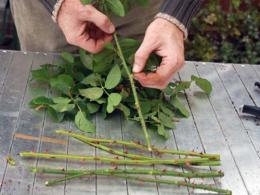
Every girl dreams of receiving a bouquet of fragrant flowers on the special day of her life. But in order for this flower to be born, you need to know how and when it is best to propagate, how to preserve the rooted rose cuttings in winter and how to plant them correctly.
Content:
- What are the advantages of autumn rose cuttings?
- How to properly prepare cuttings
- How to plant cuttings
- How to store cuttings in winter
- Rooting roses from a bouquet
- Rooting with potatoes
What are the advantages of autumn rose cuttings?
Cuttings are the propagation of flowers using a part of the plant that can restore the root under certain conditions.
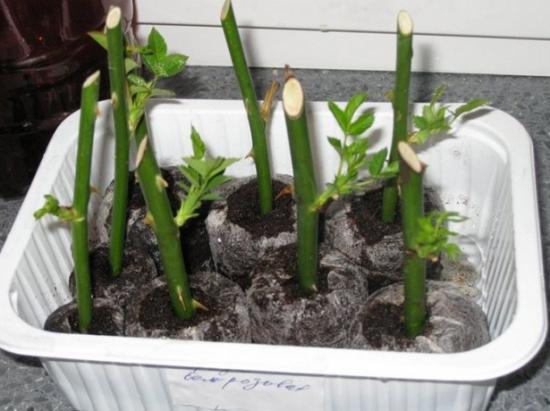
In comparison with grafting, the autumn type of cuttings roses has its advantages:
- with this method of propagation, in the area where the flower is planted, a smaller number of additional shoots are formed from the adventitious root buds, which greatly facilitates the care of the rose;
- The process of propagating roses by cuttings in the fall is convenient in terms of saving time, since it is carried out at the end of October, and it is combined with pruning the bushes;
- Such plants tolerate wintering more easily and are able to revive from dormant buds if its above-ground fragment freezes out;
- roots take root faster.
Raw materials for planting can be found quite easily.The source can be any bouquet of these flowers given to you, or you can ask for propagation material from acquaintances or friends.
The best varieties for cuttings:
- Iceberg;
- Rosalind;
- semi-climbing;
- climbing Rambler groups;
- miniature;
- polyanthaceae;
- Excelsa;
- Flammentanz.
It is important to remember that it is better to take local varieties rather than imported ones, as they are usually treated with chemicals.
How to properly prepare cuttings

To grow a beautiful rose, you must prepare it in accordance with all the rules:
- the source must be a healthy plant;
- a fairly soft green stem with a thickness of 4-5 mm and a length of 15-20 cm, so that later the rooting process will be easier;
- Make cuts with sharply sharpened knives or scissors, which must first be soaked in alcohol and moistened with boiling water;
- It is recommended to make straight cuts from above at a height of 2-3 cm from the upper bud, and from below - oblique cuts under the lower bud. Then you won’t get confused which side to plant. In this case, there should be 3-5 developed buds per cuttings;
- The thorns and lower leaves are removed completely, and a third of the upper leaves are cut off.
This is especially important if rooting is performed immediately, since green foliage provides nutrition to the stem.
How to plant cuttings
Cutting in the autumn usually leads to the planting of prepared material, which is pre-treated with one of the preparations that stimulate root formation. Each variety has its own speed of root establishment, so it is important to know that there are reactive species and those that will take root rather slowly.
During planting, the following rules must also be observed.
Choose a seat that matches the living conditions of the flower. Rose belongs to light- and heat-loving plants, so it is better to plant it in the southern sector near the fence in order to protect it as much as possible from cold winds or drafts.
Excess moisture will be detrimental to it, so underground groundwater should be located at a level of more than 1 m. The soil is preferably loose and rich in organic matter;
a hole is dug a little larger than the root system of the seedling, about 30 cm deep, then fertile soil is poured there with the addition of compost, humus (fresh manure is excluded), minerals fertilizers.
The seedling is planted in the center at an angle of 450 so that at least 3 buds remain on the surface, watered well with clean water.
A protective layer in the form of sawdust, dry leaves or peat, i.e. create a layer of mulch.
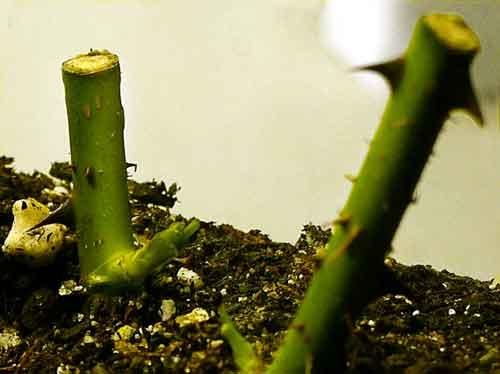
During the first days, you need to hide the plant from direct sunlight; if you are planting a row of flowers, then the interval between them should be at least 50-100 cm.
The first year it is better to pick off the buds so that the bush does not bloom, and cover it with earth for the winter.
Also, for wintering roses, you can build a small greenhouse from metal wire, covered with polyethylene and special non-woven material on top. Then cover with spruce branches and leaves. In spring, each layer is removed gradually.
How to store cuttings in winter
Winter storage of rose cuttings can be done in several ways.
On the balcony
Take available containers in the form of glassware, buckets, plastic bottles or boxes. Substrate or specially collected soil is poured there, and holes are made for air circulation. The soil is moistened and a cutting is inserted.The container is wrapped in polyethylene and covering material, you can add straw. The planting site is marked with matches or pegs. When the air temperature drops significantly, it is better to take it into the room.
In the basement
If you have a basement with good ventilation, humidity up to 70% and a temperature of 1-3 C, you can store buried seedlings in a box with moistened sand.
In a refrigerator
You can store rose cuttings in winter on the top shelves of the refrigerator. To do this, the cuttings should be placed in a tightly sealed plastic bag, the ends of the cuttings should be covered peat.
In the trenches
If storage at home is problematic, the following method is recommended:
- dig trenches 15-20 cm deep, clear of debris;
- cover the bottom with non-woven material or straw;
- arrange the shoots at equal intervals from each other;
- insulate the top with the same materials as the bottom, sprinkle with earth;
- mark the edges of the wintering area;
- Different varieties should be marked with multi-colored ribbons so as not to be confused later.
In the spring on those that have taken root seedlings a growth should appear from which roots emerge - callus, so they should be immediately planted in a permanent place or in a temporary cutting. If you cannot complete this procedure, then you should put the cuttings in water with the addition of the biostimulator Epin.
Rooting roses from a bouquet
If you are an avid gardener or are planning to grow roses for the first time, the source can be a bouquet of flowers you received for the holiday. It will be better if you start preparing the future seedling in the first days, since over time the stems of the plant will begin to rot. A rare change of water will give the opportunity for bacteria to arise that will infect such a valuable representative of the flora.
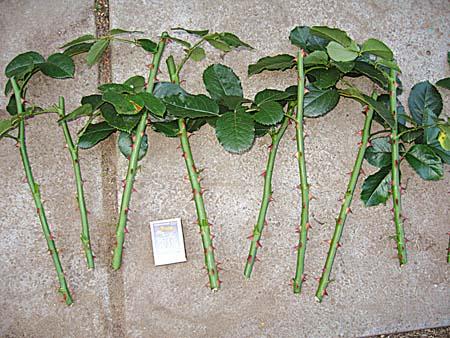
Therefore, before placing flowers in a vase, trim the edges of the stems by 2 cm and pour clean filtered water. At night, you should place the roses in a deep container so that only the buds remain above the water.
Before planting a rose in a flower pot, the cuttings should be disinfected and treated with a special agent to stimulate plant growth. Then they are left in a dry place, hidden from light, for germination, having previously been wrapped in several layers of paper, which must be moistened cyclically.
The temperature should be within 14-16 C, since at lower temperatures the roots will not be able to grow, and at high temperatures they will dry out. After 2-3 weeks, you need to inspect the seedlings for root formation and, if the result is positive, plant them in a flower pot.
In the second method, cooked and moistened food is poured into the bag. peat or other substrate where chopped parts of the stem are placed. The bag is inflated and closed tightly.
The resulting container is left in the sun for 14 days for the development of plant roots, after which the seedlings are safely planted in a container with soil.
In order to maintain the correct temperature level, the cuttings in pots are covered with glass containers, which can be removed periodically when there is a clear process of seedling growth. Over time it is removed.
The soil in the pots is gradually moistened, and the emerging leaves and sprouts are cut off in half to allow the flower to save strength before it is planted in a permanent place in the spring.
Rooting with potatoes
As a temporary primer for roses You can use regular potatoes.To do this, freshly cut propagation material is treated with a manganese solution and left in aloe juice diluted with water (1:1) for 12 hours.
Take a healthy tuber, which is first cleaned of eyes, washed and dried. Then a small hole is made with a nail, where after this time the rose is inserted with an oblique cut. The resulting object is placed in a pot filled 2/3 with soil and watered with dark pink potassium permanganate.

Then, when the upper part of the soil dries out, the plant can be water filtered water and once every 5 days – sweet water (add 2 tsp of sugar to 1 glass of liquid). Be sure to cover with a glass container to obtain a greenhouse effect and develop the root system.
If you decide to carry out this procedure in the garden, you will need a trench with a depth of 15 cm. A layer of sand 5 cm high is poured there, on which the cutting is left in potatoes. All this is sprinkled with earth so that 1 bud remains on top. The ground is watered and covered with polyethylene to create a greenhouse.
To summarize, it can be noted that it is autumn cuttings that allow you to avoid many problems when propagating this species, and to obtain healthy and fragrant flowers you need to follow certain principles, and then any method of rooting will give a positive result.
Every gardener who dreams of a rose on his plot simply needs to know the rules of its cultivation. More detailed information can be obtained by watching the video:

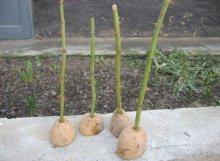

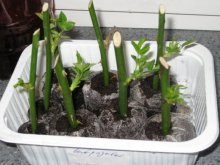









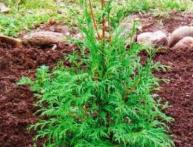
Comments
Of course, roses can be propagated from cuttings, but the winter hardiness of such flowers will be low. Therefore, rose bushes will have to be covered for the winter.The best way to breed roses is to graft a cultivated bud onto a rose hip root.